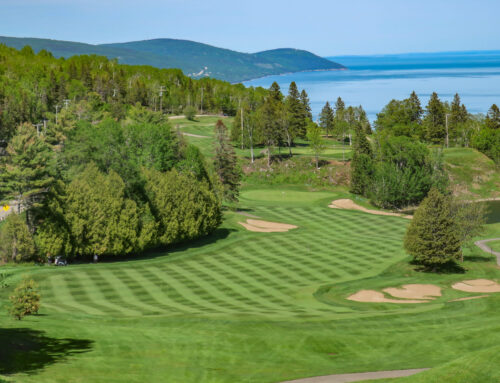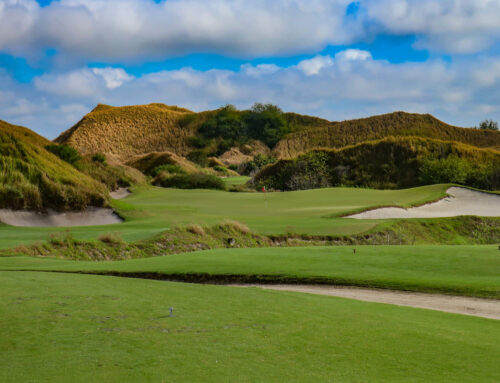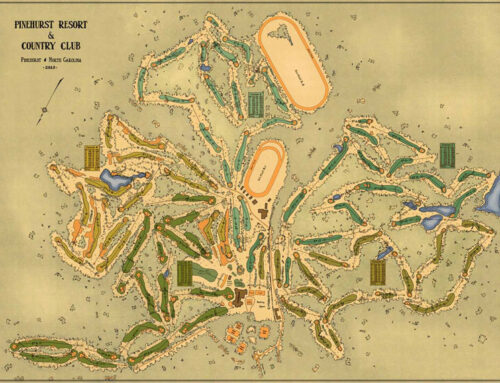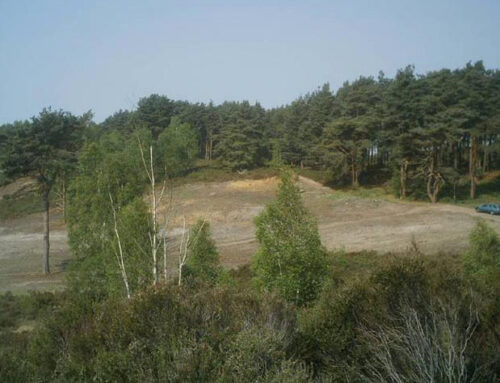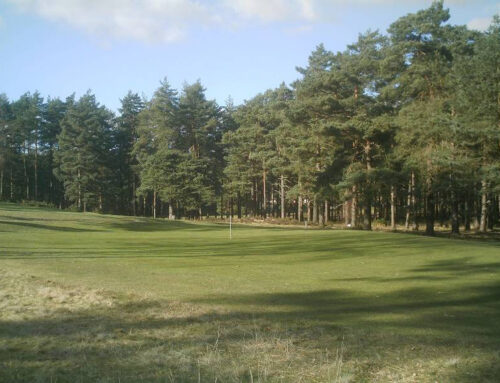The Sunningdale Story
pg.5
The “hump” at the top left of the 1934 Figure 40 is the bank at the back of today’s fifth green of the New Course. Both photos are taken from where today’s New Course sixth fairway begins. The sketch in Figure 37 shows the green much nearer the ditch than in the photo in Figure 39A, where the green is shown to be definitely on the skyline at the hilltop.
Figure 39 shows a 2011 photograph of the same ditch as is seen in Figure 38A, and taken from the same location, the beginning of today’s sixth fairway. The similarity is striking. Figure 39A is from Suttons Seeds catalogue of 1934!
The collection of Suttons seeds catalogues which included the photo in Figure 39A is held at Reading Museum of Country Life, and these books contain articles by both Harry Colt and Tom Simpson, both of whom were golf course seed consultants to Suttons The “final form” caption to the photo from Sutton’s catalogue suggests that during construction the hole was subjected to various alterations in the site of the green.
Figure 40 is the sketch map of Simpson’s tenth and eleventh holes taken from a 1934 Field monthly (ref 8). His tenth green was located on today’s eleventh fairway, as shown in Figure 21 where a very short sliced drive from today’s tee would finish, and the third shot to this par five hole is shown as being played from the vicinity of today’s ninth green. Simpson’s eleventh tee can clearly be seen in the heather just right of the path that runs from the current eleventh tee to the fairway, and about eighty yards from that tee. His eleventh hole used Colt’s original eleventh green, now also today’s eleventh green.
Figure 41 is a view of the tenth hole in 1939 after Colt and Morrison had replaced the Simpson sixth to eleventh holes.
This tee and green are the same as today and the green was part of the original Colt tenth hole, but was not used in the Simpson re-design. The original Colt tenth hole was played from a tee at the top of the hill on the left (see Figures 34 and 34A), where the tees can easily be located today. The original eleventh tee, still used today, is visible to the right of the green.
The Simpson tenth hole, was played from the (current) ninth tee and designed as a three-shotter, the third shot played over the present ninth green to a now disused site over the brow in the middle of the eleventh fairway (Figure 21). The eleventh green was re-designed as it is at present and driven from a tee nearby, the hole being much shorter than at present. This tee can still easily be seen, though now overgrown.
This green and tee combination meant a walk of per-haps two hundred and fifty yards from the tenth green to the Half Way House, a feature of Sunningdale since its earliest days and mentioned in Darwin’s “Golf Courses of the British Isles” (ref 7), and a similar distance back to the eleventh tee, affecting the popularity of Simpson’s changes.
Some golfers playing the Simpson holes would have cut out the stop at the Half Way House to the annoyance and confusion of those who had stopped and whose progress was then blocked. Half Way House revenue would have declined as a result, and it is possible that the then proprietor or staff would not have discouraged such unhappiness and gossip, resulting in the further redesign by Colt and Morrison.
The New Course Finishing Run
Mention has previously been made of the alternative green built for the twelfth hole now abandoned to the left of the current green. At the same time the present thirteenth green was designed. Harry Colt’s original hole was over six hundred yards long and driven from a tee above the present fifth to a green to the right of the current one (and fifty yards beyond the present green, with its rear border quite near today’s back fourteenth tee); and so to the eighteenth where Simpson designed a small two terraced green a little way beyond the belt of trees.
On the following pages there are an air photograph of the original Colt eighteenth green taken in 1931, and a Google Earth photo taken in 2010 with the various histori-cal green placements superimposed, based on information in the Whitfield “History of Sunningdale Golf Club: the first by Colt, the second a Tom Simpson placement, the third by Colt and Morrison in 1939, where today there is a pitching practice green, and today’s green which was created in the 1960s and altered several times, most recently in 2007.
Figure 42 is a retrospective portrait of Harry Colt by Arabella Dorman. The painting currently hangs in Sunningdale’s clubhouse. Colt is pictured at the now defunct eighth tee of the new course also seen in Fig 28. That photograph was used by the artist as the background for the picture.
Figure 43 is part of an air photo of the courses taken in 1931. Shown above right is the first of four locations for the eighteenth green of the New Course, in use 1923-1934.
In Figure 44 a Google Earth view shows the location of the various eighteenth greens; 1 is the original Colt 1923 green location seen above, 2 is the Tom Simpson location made in 1934, 3 is the Colt Morrison placement in 1939, currently the chipping practice green, 4 is the current location, created in 1957 with further alterations in 1964.
As the air photo was taken in 1931, the original New Course first green (see Figures 15 and 16) would have been replaced in 1927 by a new green where today’s first green of the New Course is located, and the first tee would have been moved to a spot out of view on the photo, but to the right of the right hand bunker guarding the original Colt eighteenth green, thereby reversing the original lines of play for the first and the eighteenth holes.
In 1935, R.H. Anketell, the Captain, drove in to open the newly constructed course. The ball was retrieved by one of the caddies who received the customary sovereign; a real one! (The reconstructed Simpson course was referred to as the Jubilee Course in recognition of the Silver Jubilee of the reign of King George V.)
The unusual Anketell name was borrowed from this Sunningdale member by Agatha Christie, as was her custom with Sunningdale members. In her 1951 book “The Hollow” she also used the name of the Hon Secretary, the Hon Montague Erskine, for the name of a family in another story. Her later divorced husband Col Christie won the club Founder’s Singles in 1926. Her earlier stories often revolved around golf courses, and after her second marriage, to an archeologist, her later stories sometimes took place at the scenes of excavations in the Middle East.
An elaborate system of drainage was installed on the new holes on the Common and still remains effective. An aerial shows this drainage work as it was undertaken. The heath fire previously referred to was a particularly extensive one, reaching right across the Common from the railway line, a part of it having almost reached the ninth green of the Old Course. Consequently the whole Common was bare and black except for the new fairways and greens.
On this account and also to the Italian-Ethiopian war then raging, the New Course was christened “Abyssinia”. This appellation helped to damn the course and it was never popular. The original Colt holes remained in occasional use for several years, up to the beginning of WW-2 as an alternative to Abyssinia.
The Colt and Morrison Alterations
Shortly before the Second World War, Harry Colt and John Morrison were asked to see what could be done about it and so the Course as it is now. One of the reasons for its unpopularity, allegedly, was the long walk between green and teeing ground on many of the holes. To assess this the writer measured the aggregate yardage from the centre of the greens to the medal tees on the Old Course, and those of the original New Course and “Abyssinia” and found barely one hundred yards difference between all three!
Somehow the Old Course has a personality of its own, not shared by the New Course. Perhaps one of the reasons was expressed recently by a professional golfer. He remarked that in his opinion the New Course was easier for the handicap golfer. As one of the latter class, the writer agrees, but if he were allowed an opinion, he would strongly assert that should the New Course have been situated twenty or more miles away and be as easily accessible as the Old, it would rank as one of the best tests of golf in the Country.
Club Personalities
From 1900 until his death, H.R.H. the Duke of Con-naught was President of the Club. He was succeeded by the Earl of Derby, since whose death no one has held that office, though Their Majesties King Edward VIII and King George VI both graciously consented to be Patrons. (The two monarchs were also both golfing Members and Captains of Sunningdale.)
The names of the Captains are inscribed on a board for all to see, and it seems fitting that the names of the Secretaries should now be recorded here. The Hon. Montague Erskine acted as Hon. Secretary in the early days, and when in full swing, H.S. Colt was appointed and remained in office until his business as a golf course architect made it impossible for him to continue, a period of about seventeen years (ref 5).
In fact Colt was appointed secretary in July 1901 and resigned in 1913, although he attended green committee meetings for a further two years. The details of Colt’ s time at the Club are recorded in a chapter in Fred Hawtree’s biography, Colt & Co, published in 1991.
In 1919, F.P. Le Marchand became Secretary and continued till his death early in 1933. T.A. Roberts carried on for a few months until the writer was appointed and took up duties in November of that year. The war terminated his engagement, as it did the careers of many younger members of the green staff. James Moir was Hon. Secretary for the duration of the war, putting in what time he could spare from other duties.
During the war the Clubhouse was taken over by the War Office and a temporary Club House was made out of the caddie enclosure. At the end of the war the original building required a great deal of re-conditioning as did the New Course which, owing to shortness of staff and for lack of money, had been allowed to fall into disuse, work being done there only to prevent complete disinte-gration.
G.G. Kirke was appointed secretary after the war. After five years he was succeeded by Bernard Drew, previously Secretary at the Royal Cinque Ports Golf Club, Deal, for twenty years. Drew retired in 1960, and Commander L.A. Jeffery, O.B.E., R.N., who had been Assistant Secretary for some years, was appointed in his place.
Very soon after the war, work was started to put the New Course back into condition. This was made possible by the hard work of Jim MacLean, who has now succeeded his father as Head Green Keeper, and the members of the Artisan Section of the Club, who in return for their services were granted additional playing rights.
It would be invidious to mention the names of the many well known golfers who have been and are members of the Club, in case some may be inadvertently left out. Only once, however, has the Amateur Championship Cup reposed in the Club House when, in 1949, it was won by Max McCready. In 1906 no less than three of the four semi-finalists were members, H.S. Colt, E.A. Smirke and C.C. Lingen. However, James Robb from Lingen, the only non member, was the eventual winner. The Club’s Professional, Jack White, won the Open Championship at Sandwich in 1904.
Worth mentioning is the fact that Willie Park, who laid out the Old Course, did win the Open Championship on two occasions.
Note: Fig 45 is a retrospective portrait of Willie Park Jnr, by Arabella Dorman, depicted standing near the tenth tee of Sunningdale Old Course.
The putter which Jack White used in his Open win is now in possession of the Club. Furthermore, Sunningdale members Cyril Tolley (1920 and 29), John de Forest (1931), Bobby Sweeny (1937), and Sam (Max) MacCready (1949), did win the Amateur Championship. Bobby Sweeny also lost the final of the 1954 US Amateur Championship to Arnold Palmer at the final hole, whilst having a temperature of 102 degrees all that day. Max McCready, a Northern Irishman, won at Portmarnock but entered from Sunningdale. Honorary members Michael Bonallack and Joe Carr collectively won eight times, and several members have won their National Closed events.
There is a well researched section on Sunningdale members and their impact on the Amateur Championship and Walker Cup on pages 107-117 of Whitfield’s Sunningdale Golf Club 1900-2000, available from the Club or on the internet.
The Club has been well and faithfully served by many of its staff. Mention has already been made of Hugh MacLean, head Green Keeper for forty years, and Bert Chapman still in service after over 50 years. Godfrey and Hampton remain on the Green staff with nearly thirty years service.
Miss Charman came originally as Harry Colt’s personal Secretary handling his outside work but eventually, at his special request, took over the position of Manageress, and with her brother in the bar and later with Miss Paget, carried on for very many years. Miss Charman now lives in retirement in her cottage in Windlesham with Miss Paget. Arthur Wigmore has for 46 years reigned over the dressing and locker rooms. The holder of the rarely awarded Distinguished Conduct Medal, he remains the friend of countless members and visitors.
Figure 46 is the portrait of Jimmie Sheridan hanging in Sunningdale Golf Club. After it was painted it was dis-played for a time in the Royal Academy.
Last but far from being least comes that wonderful character James [Jimmie] Sheridan, Caddie Master for fifty years. His sense of humour, wit and powers of repartee are known to golfers from all parts of the world. No further evidence of the esteem in which he is held is required than the facts first, that his portrait painted by Martin Ronaldson, once in the Royal Academy, now hangs in the Clubhouse, and secondly that he is now an Honorary member of the Club.
A silver salver presented to Sheridan by club members on his retirement was re-presented to Sunningdale by his son John Sheridan, professional at Denham for many years. Sheridan was also the author of a unusual golfing history book, “Sheridan of Sunningdale”, which records the early history of the club and the fifty years of service as Caddie Master, and contains many anecdotes of the early years of the club and its association with members of the Royal Family, politicians and noted celebrities of the time. Second hand copies are regularly offered for sale on the internet via Amazon or Abebooks.
Jimmie Sheridan’s son John grew up at Sunningdale, and became an excellent golfer before turning professional and later becoming the professional at Denham. Members of that club published a book “Sheridan of Denham” in which a chapter by John covers his life at Sunningdale in the 1930s.
Of the Professionals attached to the Club, Jack White was the first. One time Open Champion, he employed six or seven club makers and had a large overseas market. Ernest Sales with his two sons came next, none of them great golfers, but who looked after their shop and their club making, now a fast dying art. After them, Michael Bingham was appointed from a large number of applications.
Owing to illness Bingham left suddenly and Percy Boomer, having escaped from St. Cloud before the Germans overran France, took over temporarily and later permanently. Percy had his own methods of teaching and was the author of a book on the subject. He possessed a unique collection of golfing publications and books by every known author, mostly signed copies. On his death Arthur Lees was appointed and carries on his golfing successes in spite of the onset of a younger generation. Since then Clive Clark, now a well known golf course designer, and Keith Maxwell have carried on his tradition.
Thus Sunningdale! The story has been written in the belief that it may be of interest not only to those who can remember things as they were, but to those of a later generation who know nothing of them. It may also serve as a record of the evolution of the two courses from their first beginnings.
Guy Bennett 1962
John Churchill Editor 2012
Epilogue
Extract from Bye-Laws 1902:
Caddies shall be paid at the following rates:
[i] 1st Class 1/- per round of 18 holes; 6d for 9 holes or less
[ii] 2nd Class 9d per round for 18 holes; 5d for 9 holes or less
[iii] Lunch money 6d. if engaged for whole day
[iv] Booking fee one penny per round
References
1 History of Sunningdale Golf Club: John Whitfield. 2000.
Available from Sunningdale Golf Club £35 plus post-age
2 Sheridan of Sunningdale: Jimmy Sheridan. 1967; Usually available from www.amazon.co.uk.
3 The Sunningdale Golf Club: Bernard Darwin. 1924. See also ref 12 below.
4 Some Essays on Golf Architecture: HS Colt and CH Allison. 1920.
5 Colt & Co: Fred Hawtree. 1991: likely to be reprinted in the next 2-3 years. For extract see also ref 12 below
6 The Architectural Side of Golf: R Wethered and T Simpson. 1929.
7 The Golf Courses of the British Isle: Bernard Darwin. 1910: recently reprinted and available from Amazon. For extract see ref 12 below.
8 The Field. July 14, 1934
9 www.oldgolfimages.com is a large collection of historic golf photographs assembled by Dale Con-cannon.
10 www.golfclubatlas.com is a fascinating web site for those interested in golf course architecture, golf history, or golf courses: particularly a discussion to be found at: https://golfclubatlas.com/forum/index.php?PHPSESSID=erhg5rqcrib7u4eu6gbraafoj4&topic=43594.0
11 Sunningdale Golf Club: A series of booklets by Robert Browning, author of “The History of Golf”. The booklets were published and regularly updated between 1950 and 1964, and are often available from internet sources.
12 http://www.sunningdale-golfclub.co.uk/heritage/history
Sunningdale Golf Club web site, Visitor’s heritage tab and links.
13 “Golf Course Architecture” April 2012 ,published in the UK, carries an excellent three page article on the Colt lost holes at Sunningdale, featuring excellent current day photographs and a 1945 RAF air photograph with the tracks of the lost holes superimposed on it.
Appendix
Fig 47 Google Earth photo shows the layout of the extinct Chauffer’s Course described immediately before the section on the New Course: The eighteenth green of the Old Course is top left. The Chauffer’s first hole was located on today’s New Course first hole and similarly the third holes are concurrent. The Chauffer’s ninth hole ran back down today’s practice ground. The reservoirs are seen at the bottom of the photograph.
The End













